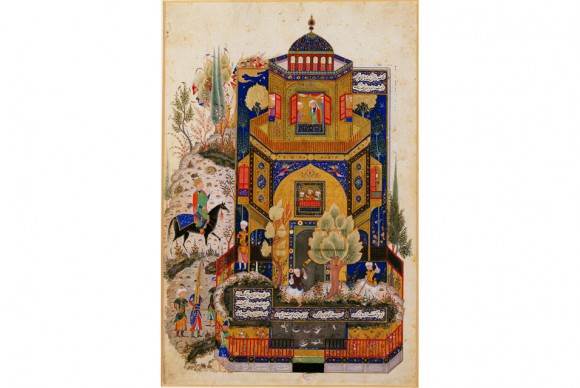Dallas Museum of Art to receive one of world’s largest Islamic art collections: The Keir Collection
February 5, 2014 by All Art News
Filed under Art Events & Exhibitions
DALLAS, TX.- The Dallas Museum of Art announced today that it will receive a long-term loan of one of the world’s largest private holdings of Islamic art, transforming the Museum’s Islamic art collection into the third largest of its kind in North America. Assembled over the course of five decades by the noted art collector Edmund de Unger (1918–2011), the Keir Collection is recognized by scholars as one of the world’s most geographically and historically comprehensive, encompassing almost 2,000 works in a range of media that span 13 centuries of Islamic art-making. This rarely exhibited collection will arrive at the DMA in May 2014 on a 15-year renewable loan, advancing the Museum’s growing focus on new models for collection-building and cultural exchange.
Named after the 18th-century British mansion where it was once housed, the Keir Collection includes textiles, carpets, ceramics, rock crystal, metalwork and works on paper. The collection’s geographic range spans from the western Mediterranean to South Asia. Under the terms of the loan agreement, the DMA will establish a new gallery space dedicated to showcasing works from the Keir Collection, and will also create the first-ever digital archive of the collection to enhance its accessibility for scholarship and public engagement.

Khusraw at Shirin’s palace. Miniature from a manuscript of the Khamsa of Nizami Tabriz (Persia), late 15th century. Ink, and pigments on paper, 7 5/8 x 4 1/2 in. (19.5 x 11.5 cm). The Keir Collection of Islamic Art on loan to the Dallas Museum of Art.
“We are deeply grateful to the Collection’s Trustees for entrusting us with this unparalleled collection, which will enhance the DMA’s growing strengths in the area of Islamic art,” said Maxwell L. Anderson, the Museum’s Eugene McDermott Director. “The long-term loan of these magnificent works reflects the Museum’s commitment to collection-building strategies that keep important works of cultural heritage in international circulation, for the benefit of audiences both locally and globally.”
Richard de Unger, a son of the collector, said, “We are pleased that my father’s collection is being transferred to the care of a museum whose commitment to fostering cross-cultural dialogue has made it a leader among its peers. Our late father believed that Islamic art and culture was the bridge between the Far East and the West. It is with this concept in mind that we viewed the DMA as the ideal partner to communicate this. It is by exhibiting these rare and beautiful works that we hope to increase the understanding of the Islamic heritage and realize the enormous contribution it has made to our own cultural identity. The DMA’s innovative curatorial strategies and exemplary visitor engagement practices will ensure that these works become a cherished resource for the Museum’s diverse community in the years to come.”
This Keir Collection loan affirms the DMA’s commitment to expanding its collection through long-term loans and cultural exchanges, as a complement to its robust acquisitions program. With the 2012 appointment of Sabiha Al Khemir as the DMA’s first Senior Advisor for Islamic Art, loans of Islamic art have been a particular area of collection growth over the past year. Shortly after her appointment to the DMA, Dr. Al Khemir began conversations with the representatives of the Keir Collection regarding its future.
The Keir Collection’s arrival at the DMA exemplifies the Museum’s DMX program, which was launched in 2012 and facilitates loans of cultural objects from international organizations in exchange for the Museum sharing its expertise in conservation, exhibitions, education and new media. Texas has the fifth largest Muslim population in the United States, and until now Dallas has been the only one of the four largest metropolitan areas in the nation lacking a significant public display of the art of the Islamic world. None of the projects of DMX, including the Keir loan, involve fees, but instead are intended to foster scholarship, relationship-building and lifelong learning.
Reflecting the tastes of Edmund de Unger—a Hungarian-born lawyer who began collecting Islamic art in the 1950s—the Keir Collection is particularly strong in the fields of early lustre ceramic ware, while the rock crystal—including the recently discovered Fatimid Ewer—is perhaps the most important collection of its type outside the treasury of San Marco in Venice. Other highlights include the sumptuous silk textiles with their intricately drawn designs from the imperial workshops of 16th- and 17th-century Safavid Iran, and then there are distinctive examples of illuminated figurative manuscripts from the 14th to 17th century. With the exception of an exhibition of some 100 works at the Museum of Islamic Art in Berlin in 2007–08, most of the collection has never been exhibited in a museum setting prior to its arrival at the DMA.
“With distinctive strengths across nearly every major period of Islamic cultural production, the Keir Collection is one of the most important collections of Islamic art ever assembled,” said Sabiha Al Khemir. “We are thrilled by the opportunity to showcase this remarkable collection with new exhibition strategies and scholarly research that will illuminate the rich heritage of the Islamic world.”
“The breathtaking historical and geographic scope of the Keir Collection has made it an indispensable resource for scholarship in the field of Islamic art,” said Dr. Thomas W. Lentz, the Elizabeth and John Moors Cabot Director of the Harvard Art Museums, and a noted scholar of Islamic art. “Beyond its remarkable breadth, the collection offers singular insights into important areas of Islamic art history—in particular the development of Islamic ceramics during the medieval period.”
